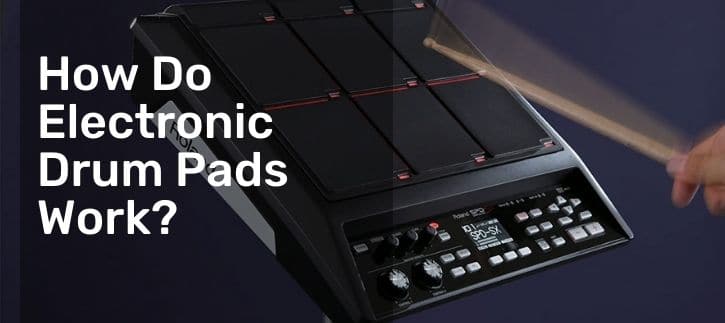The world of musical instruments is transforming day by day, and this is apparent in the evolution of electronic drum pads.
Some people often mistake electronic drum pads for sample pads. Though the two appear similar, they are totally different.
Electronic drum pads can be used instead of drum kits because they have internal speakers. However, you can also use drum pads to complement your electronic drum kit.
If you want to expand the sound range of your acoustic kit, you can use sample pads. Also, you can use them alongside your electronic kit to add effects and loops.
Electronic drum pads are an excellent choice for beginners, kids, and teens. Unlike acoustic drums, electronic drum pads are incredibly quiet. As such, you can use them for practice in shared accommodation or an apartment with no soundproofed walls/ ceiling.
Also, there are many famous drummers who use electronic drums in live performances. Besides triggering basses, these drums have top-notch features that make them fit for professional drumming.
They are pretty easy to learn as you have fun.
So, how do electronic drum pads work?
For electronic drums to produce sound and deliver the required performance, they use the brain and transducers.
The Brain
The brain is a common term in the world of electronic drums. It is another name for the sound module or drum module.
The brain is responsible for producing all the drum sounds and running other key features of the kit, such as presets.

Drum modules vary in terms of additional sound effects, type, and sound quality. The best thing about electronic drums is that even the most basic kit offers a variety of sound selection.
You will get a variety of genres like hip-hop, jazz, brush, rock, and vintage electronics, among others.
Advanced kits offer a wide variety of preset kits. Also, they come with a kit customization option. With this, you can set up your preferable kits from the onboard drum sounds and edit sounds to your liking.
For the basic kits, customization allows you to EQ or dampen individual drums, tune and adjust volumes of individual drums. With advanced models, you can specify the materials and dimensions of individual components and design your personalized drums.
Most drum modules operate through PCM sample sound technology. Meaning, the module generates sound by replaying recorded drum sounds when you strike trigger pads.
Other key features of the brain are the ability to record performances, play-along tracks, and onboard coaching exercises.
The brain has individual inputs for each drum trigger.
Transducers
Transducers are drum triggers or trigger pads. They are the beats you play on an electronic drum. Once you hit the trigger pad, a message is sent to the brain. The brain interprets the trigger and produces a corresponding note in the form of sound.
Most electronic drums have a set of five trigger pads, just like their acoustic counterparts. However, high-end modules come with additional trigger inputs in case you may wish to add more in the future.

Usually, drum triggers have a kind of pickup that senses vibrations. They relay sound according to how you command them.
When you strike the trigger, the pickup senses the level of vibration (how hard it has been hit). If you hit it hard, many signals go to the drum module, resulting in a higher sound and vice versa.
Modern triggers can trigger different sounds since they have multiple zones. Also, they feature multiple pickups to facilitate responsive and dynamic triggering.
Features that Make Up the Best Electronic Drum Pad
Besides brain and trigger pads, there are other key components that make an electronic drum pad great. These features are crucial in helping you make an informed buying decision.
1. Number of Pads and Pedals
You are not likely to use an e-drum pad throughout your life. At some point in time, you will want to change to a more advanced drum kit, electronic or acoustic.
An ideal digital drum pad should have a similar number of drum and cymbal pads as that of a real drum set. These include:
- Four drum pads – one for the snare and the rest for three toms
- Two pedals – one for the hi-hat and the other for bass drum
- Three cymbal pads – for hi-hat, ride cymbal and crash cymbal.
With these components, you can be sure of an easy transition in the future.
2. Sound Range
The sound range is the individual sounds stored in your electronic drum pad.
Some drum pads come with plenty of onboard sounds, while others just have a few. Pads with many sounds are preferable since they have more flexibility than their counterparts. You can create personalized kits or switch between the onboard sounds.
Also, some electronic drum pads allow you to assign sounds on a pad-to-pad basis. Others will only allow you to change all sounds of a particular range as a whole. The pad-to-pad basis is better since it has more room for customization.
3. Inputs and Outputs
A 1.4-inch input is a crucial consideration if you want to play along with your smartphone or Mp3 device.

You should also ensure that it has a headphone input to facilitate silent playing. A MIDI or USB input is necessary if you wish to record and modify your tracks.
Frequently Asked Questions
How can I record on my electronic drum pad?
How loud are electronic drum pads?
Conclusion
Electronic drum pads are the best to use if you want to learn or improve your drumming skills. It is recommendable to invest in a high-end model for an excellent performance.
Such models come with more preset options, onboard coaching, play-along tracks, and other fantastic tools.

